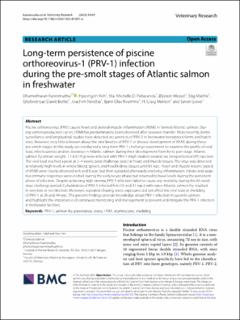| dc.contributor.author | Kannimuthu, Dhamotharan | |
| dc.contributor.author | Roh, HyeongJin | |
| dc.contributor.author | Penaranda, Ma Michelle Demogina | |
| dc.contributor.author | Wessel, Øystein | |
| dc.contributor.author | Mæhle, Stig | |
| dc.contributor.author | Ghebretnsae, Dawit Berhe | |
| dc.contributor.author | Nordbø, Joachim | |
| dc.contributor.author | Kvamme, Bjørn Olav | |
| dc.contributor.author | Morton, Hugh Craig | |
| dc.contributor.author | Grove, Søren | |
| dc.date.accessioned | 2023-09-27T10:31:59Z | |
| dc.date.available | 2023-09-27T10:31:59Z | |
| dc.date.created | 2023-09-14T09:41:59Z | |
| dc.date.issued | 2023 | |
| dc.identifier.citation | Veterinary research (VR). 2023, 54 (1), . | en_US |
| dc.identifier.issn | 0928-4249 | |
| dc.identifier.uri | https://hdl.handle.net/11250/3092328 | |
| dc.description.abstract | Piscine orthoreovirus (PRV) causes heart and skeletal muscle inflammation (HSMI) in farmed Atlantic salmon. During salmon production cycles, HSMI has predominantly been observed after seawater transfer. More recently, better surveillance and longitudinal studies have detected occurrences of PRV-1 in freshwater broodstock farms and hatcheries. However, very little is known about the viral kinetics of PRV-1 or disease development of HSMI during these pre-smolt stages. In this study, we conducted a long-term PRV-1 challenge experiment to examine the profile of viral load, infectiousness and/or clearance in Atlantic salmon during their development from fry to parr stage. Atlantic salmon fry (mean weight: 1.1 ± 0.19 g) were infected with PRV-1 (high virulent variant) via intraperitoneal (IP) injection. The viral load reached a peak at 2–4 weeks post-challenge (wpc) in heart and muscle tissues. The virus was detected at relatively high levels in whole blood, spleen, and head kidney tissues until 65 wpc. Heart and muscle lesions typical of HSMI were clearly observed at 6 and 8 wpc but then subsided afterwards resolving inflammation. Innate and adaptive immune responses were elicited during the early/acute phase but returned to basal levels during the persistent phase of infection. Despite achieving high viremia, PRV-1 infection failed to cause any mortality during the 65-week virus challenge period. Cohabitation of PRV-1 infected fish (10 and 31 wpc) with naïve Atlantic salmon fry resulted in very low or no infection. Moreover, repeated chasing stress exposures did not affect the viral load or shedding of PRV-1 at 26 and 44 wpc. The present findings provide knowledge about PRV-1 infection in juvenile salmon and highlight the importance of continued monitoring and management to prevent and mitigate the PRV-1 infection in freshwater facilities. | en_US |
| dc.language.iso | eng | en_US |
| dc.title | Long-term persistence of piscine orthoreovirus-1 (PRV-1) infection during the pre-smolt stages of Atlantic salmon in freshwater | en_US |
| dc.title.alternative | Long-term persistence of piscine orthoreovirus-1 (PRV-1) infection during the pre-smolt stages of Atlantic salmon in freshwater | en_US |
| dc.type | Peer reviewed | en_US |
| dc.type | Journal article | en_US |
| dc.description.version | publishedVersion | en_US |
| dc.source.pagenumber | 15 | en_US |
| dc.source.volume | 54 | en_US |
| dc.source.journal | Veterinary research (VR) | en_US |
| dc.source.issue | 1 | en_US |
| dc.identifier.doi | 10.1186/s13567-023-01201-w | |
| dc.identifier.cristin | 2174965 | |
| dc.relation.project | Havforskningsinstituttet: 15821 | en_US |
| dc.relation.project | Havforskningsinstituttet: 15533 | en_US |
| cristin.ispublished | true | |
| cristin.fulltext | original | |
| cristin.qualitycode | 2 | |
